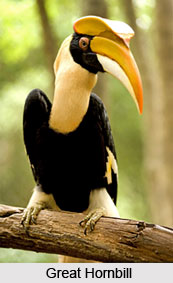 The Great Hornbill is also known as the Greater Indian Hornbill and is the largest member of the Hornbill family. Other than India it is also found in the Malay Peninsula and Sumatra, Indonesia. The Great Hornbill has a long lifespan extending over fifty years.
The Great Hornbill is also known as the Greater Indian Hornbill and is the largest member of the Hornbill family. Other than India it is also found in the Malay Peninsula and Sumatra, Indonesia. The Great Hornbill has a long lifespan extending over fifty years.
This large bird is nearly four feet tall with a sixty-inch wingspan. The tail weathers are as long as thirty-six inches and weighs approximately six pounds. The most striking feature of the hornbill is the bright yellow and black helmet on top of its massive bill. As such the helmet is of no use although they are believed to be the consequence of sexual selection.
The female hornbills are smaller in size than the males and have blue eyes instead of red.
Female hornbills seek shelter in the hollow of large tree trunks and the entrance is sealed with faeces, wood bark and dirt. She is confined to the nest while the chicks are growing and relies on the male hornbill for food. She lays one or two eggs at a time and the incubation period is for thirty-eight to forty days.
The Great Hornbill feeds on fruits. It also consumes small mammals, birds, lizards, snakes and insects. The birds usually form monogamous pair bonds and live in a group, which consists about two to forty individuals.
The bird has been ranked as a near threatened species owing to its hunting and lose of habitat. It is a state bird of Kerala.



















